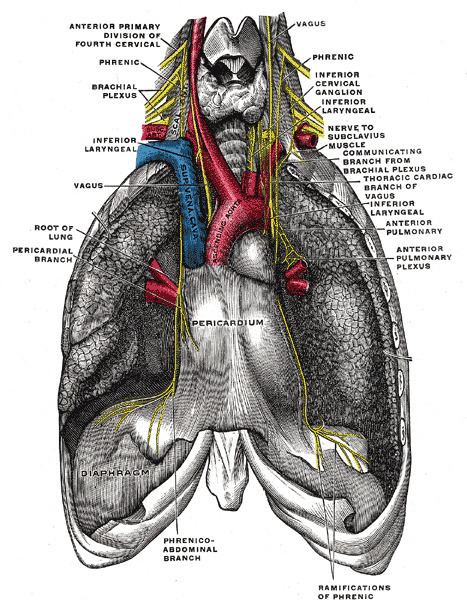 | ||
Diaphragm pacing, also known as phrenic nerve pacing (and even earlier as electrophrenic respiration), is the rhythmic application of electrical impulses to the diaphragm to provide ventilatory support for respiratory failure or sleep apnea. Historically, this has been accomplished through the electrical stimulation of a phrenic nerve by an implanted receiver/electrode, though today an alternate option of attaching percutaneous wires to the diaphragm exists.
Contents
History
The idea of stimulating the diaphragm through the phrenic nerve was first firmly postulated by German physician Christoph Wilhelm Hufeland, who in 1783 proposed that such a technique could be applied as a treatment for asphyxia. French neurologist Duchenne de Boulogne made a similar proposal in 1855, though neither of them tested it. It wasn't until a year later that Hugo Wilhelm von Ziemssen demonstrated diaphragm pacing on a 27-year-old woman asphyxiated on charcoal fumes by rhythmically faradizing her phrenic nerves, saving her life. Duchenne would later in 1872 declare the technique the "best means of imitating natural respiration." However, advances in mechanical ventilation by the likes of George Poe in the early twentieth century ended up being initially favored over phrenic nerve stimulation.
Harvard researchers Sarnoff et al. revisited diaphragm pacing via the phrenic nerve in 1948, publishing their experimental results on dogs. In a separate publication a few days before, the same group also revealed they had an opportunity to use the technique "on a five-year-old boy with complete respiratory paralysis following rupture of a cerebral aneurysm." Referring to the process as "electrophrenic respiration", Sarnoff was able to artificially respirate the young boy for 52 hours. The technology behind diaphragm pacing was advanced further in 1968 with the publication of doctors John P. Judson and William W. L. Glenn's research on the use of radio-frequency transmission to at whim "adjust the amplitude of stimulation, and to control the rate of stimulation externally." Teaming up with Avery Laboratories, Glenn brought his prototype device to commercial market in the early 1970s.
By the early 1990s, long-term evaluations of the technology were being published, with some researchers such as Bach and O'Connor stating that phrenic nerve pacing is a valid option "for the properly screened patient but that expense, failure rate, morbidity and mortality remain excessive and that alternative methods of ventilatory support should be explored." Others such as Brouillette and Marzocchi suggested that advances in encapsulation and electrode technologies could improve system longevity and reduce damage to diaphragm muscle. Additionally, new surgical techniques such as a thoracoscopic approach began to appear in the late 1990s.
In the mid-2000s, U.S. company Synapse Biomedical began researching a new diaphragm pacing system that wouldn't have to attach to the phrenic nerve but instead depended on "four electrodes implanted in the muscle of the diaphragm to electronically stimulate contraction." The marketed NeuRx device received several FDA approvals under a Humanitarian Device Exemption (HDE), one in 2008 and another in 2011.
Methodology and devices
The basic principle behind a diaphragm pacing device (the U.S. Food and Drug Administration identifies the device as a "diaphragmatic/phrenic nerve stimulator") involves passing an electric current through electrodes that are attached internally. The diaphragm contracts, expanding the chest cavity, causing air to be sucked into the lungs (inspiration). When not stimulated, the diaphragm relaxes and air moves out of the lungs (expiration).
According to the United States Medicare system, phrenic nerve stimulators are indicated for "selected patients with partial or complete respiratory insufficiency" and "can be effective only if the patient has an intact phrenic nerve and diaphragm." Common patient diagnoses for phrenic nerve pacing include patients with spinal cord injury, central sleep apnea (i.e., Ondine's curse), and diaphragm paralysis.
There are currently three commercially distributed diaphragm pacing devices: Synapse Biomedical, Inc.'s NeuRx (USA), Avery Biomedical Devices, Inc.'s Mark IV Breathing Pacemaker (USA), and Atrotech OY's Atrostim PNS (Finland). The Synapse and Avery devices are distributed worldwide and approved for use in the United States. The Atrotech device is not available in the U.S.
Surgical procedure
In the case of the Atrostim and Mark IV devices, several surgical techniques may be used. Surgery is typically performed by placing an electrode around the phrenic nerve, either in the neck (i.e., cervically; an older technique), or in the chest (i.e., thoracically; more modern). This electrode is connected to a radiofrequency receiver which is implanted just under the skin. An external transmitter sends radio signals to the device by an antenna which is worn over the receiver. For the cervical surgical technique, the phrenic nerve is approached via a small (~5 cm) incision slightly above, and midline to, the clavic. The phrenic nerve is then isolated under the scalenus anticus muscle. For the thoracic surgical technique, a small (~5 cm) incisions over the 2nd or 3rd intercostal space. The electrodes are placed around the phrenic nerves alongside the pericardium. Use of a thorascope allows for this technique to be performed in a minimally-invasive manner.
In the case of the NeuRx device, a series of four incisions are made in the abdominal skin. Several tools such as a laparoscope and probe are used to find the best four locations on the diaphragm to attach four electrodes, which have connections outside the body. A fifth electrode is placed just under the skin in the same area. All these connect to the device.
